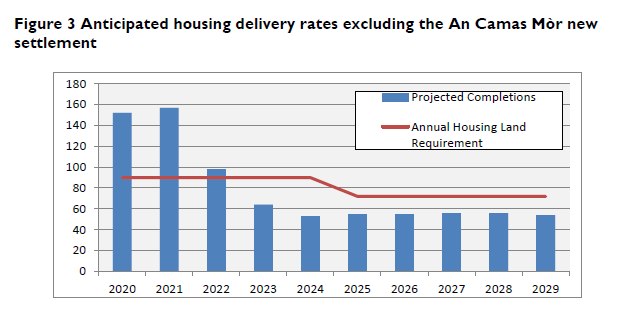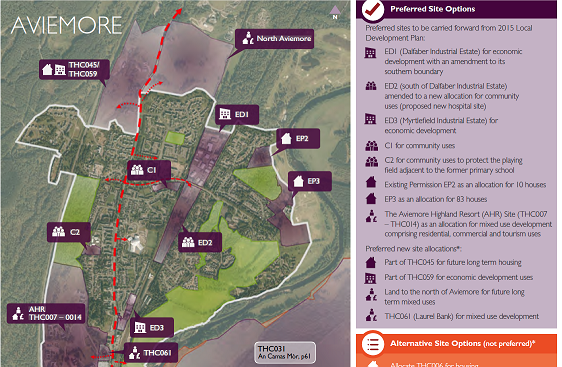
The consultation on the Cairngorms National Park Authority Main Issues Report ends tomorrow. Following previous posts (see here) and (here), this post takes a closer look at housing, which plays a prominent role in the report and features within a number of the Main Issues identified.
Main Issue 2 Designing Great Places
The Report notes that Scottish Planning Guidance now covers designing great places and has identified 6 qualities (Distinctive, Safe and Pleasant, Welcoming, Adaptable, Resource Efficient and Easy to Move Around and Beyond) which it says are necessary to achieve this. The CNPA suggests these should be incorporated into CNPA planning policy and apply to all developments whatever their size.
In my view this does not go nearly far enough and lots depends on how it is interpreted. Larger housing developments in the Cairngorms National Park, most notably in Aviemore, have destroyed local character and are characteristic of suburban type sprawl you could come across anywhere. One thing the Scottish Government Guidance lacks is any guidance about how housing and “place” design fits with the wider landscape and more specifically areas of high landscape importance like National Parks.

Contrast the housing estates with the Victorian buildings in the Cairngorms which still look good (though they may be highly energy inefficient). This is partly because they are built out of natural materials and the CNPA, I believe, needs to build on that legacy. There are some beautiful new houses in the Cairngorms National Park but they tend to be isolated and not constructed by the volume house builders. Its the volume house building which has been the problem and although the developers behind An Camas Mor are trying to address this issue with Gehl Architects, unfortunately that development is in the wrong place.
Another reason for the suburban sprawl is the lower density of the newer housing developments. While the Victorian middle classes of course did have their own gardens, look at the older villages and the houses line the main streets side by side. The contrast between Kingussie and Aviemore is striking. One way to reduce the pressure for development land would be to increase housing density within developments. Maybe the CNPA needs to start putting the case that people living in National Parks shouldn’t need private driveways and large gardens when they are surrounded by countryside. Its not housing itself which is poses the problem for nature conservation but the way current design consumes land round about.
Main Issue 4 Housing

In October, Parkswatch covered the work that the CNPA has done to assemble data about housing in the National Park and to project future demand (see here). This was based on Local Authority Housing Need and Demand Assessments. While these are are far from an exact science and arguably start from the wrong place for a National Park, being based on demand rather than carrying capacity, the really important thing is that this work shows that existing sites allocated for development are almost sufficient to meet demand and there is no need to build An Camas Mor to meet Scottish Government driven housing targets.

While the CNPA proposes allocating some new land for housing on the north side of Aviemore in case An Camas Mor does not go ahead, it could go a step further and allocate this land for housing NOW and drop An Camas Mor from the Local Development Plan. The developers behind ACM appear to have realised this and I don’t believe the recent community consultation (see here), in which glossy leaflets about ACM were delivered through doors across Speyside, was a coincidence. The developers are fearful that the local community could conclude ACM is not needed and suggest its dropped.

I believe there is no justification for An Camas Mor and the development of a smaller site on the north side of Aviemore is a much better alternative. The new site is is far less prominent in landscape terms – ACM is located on raised glacial till which has not been eroded away by the River Spey – and better situated to meet any increase in demand for housing in Aviemore which results from the dualling of the A9 and people wanting to commute into Inverness. In the longer-term, however, the CNPA should resist any further extension of the boundaries of Aviemore.

Its disappointing that the CNPA did not, in the housing section, mention the small but significant number of derelict buildings within the National Park and the potential to put these back into use. That however might have meant challenging the right of landowners to abandon buildings.
Main Issue 5 The Affordability of Housing

The analysis of the lack of “affordable” housing in the National Park, which stems from the financial crisis ten years ago which hit all those who did not already own houses, is welcome as is the wish of the CNPA to do something to tackle it. Their proposals, to increase the proportion of affordable housing in certain villages to 40% of all new housing, while quite brave given current neo-liberal orthodoxy which would leave everything to the market, do not go nearly far enough. Affordable housing is NOT the same as social housing and setting this at 40% will not provide sufficient housing for the many people who are working in the National Park on or around minimum wage levels and require somewhere decent to live. In my view to meet housing needs ALL new housing in and around Aviemore (including anywhere that is in reasonable commuting distance) that is not social housing should be affordable and, if private developers cannot deliver this, land could be compulsorily purchased and handed over to social housing providers.
The foundation for sustainable economic development is that all people living in the National Park should have somewhere decent to live. Again, the proposal to increase the proportion of smaller homes in housing developments is a step in the right direction – given the situation of people working in the tourist industry – but almost certainly does not go far enough.
Main Issue 8 – Essential Facilities
While this section is titled facilities, its really about infrastructure. It starts off discussing issues such as how to increase school size if new housing developments go ahead, but moves onto a discussion about how planning obligations could be be used to require developers to improve infrastructure. The section makes no mention of the sort of travel infrastructure necessary to make great places – whether footpaths, cycle ways or bus services – and should do so. While there has been a lot done to better connect local communities in the National Park with paths, public transport provision lies far behind.

A very good critique of the CNPA’s Main Issues Report. As you say, there is no justification for proceeding with An Camus Mor and housing demand can be met from other identified sites. We should not be influenced by the slick design work that Gehl has put in on An Camus Mor – yes they are a professional outfit – but focus on realistic housing needs and the major adverse impact An Camus Mor would have on the environment. The money spent on promoting this new town would have been much more productively spent trying to fix the bad planning issues that have dogged Aviemore for decades. Even Gehl heavily criticised the design of the new shopping area which is under construction – yes bad design and planning is still prevalent today in the Cairngorms National Park.
Concerning affordable housing, low rent social housing is needed, but unless second home ownership is curbed within the Park, families living and working in the Park will find it more an more difficult to upsize to cope with expanding families. Despite commenting about the effect that second homes have in increasing house prices, yet again CNPA has ducked the issue of second home ownership.
The Main Issues Report does raise a raft of issues that CNPA do not seem to want to or be capable of tackling. However even if we raise the concerns we have, will CNPA listen? Their track record of listening to the views of community councils and concerned members of the public objecting to aspects of proposed development is abysmal. Also it is not helped by CNPA Head of Planning commenting at a Planning Committee meeting in December 2017 that the existing LDP and associated development briefs were only guidance implying that the Committee had ‘free reign’ to deviate.
An Camas Mor was proposed by the Community Council to meet housing demand for the next 30 years – not the next 5 to resolve some of the issues of bit-by-bit, strip development without sufficient amenities or workplaces that have dogged Aviemore.
A site that is proposed to meet housing needs for 5 years is almost always going to be smaller than a site to proposed to meet the needs of the next 30.
Mr Kempe’s link between densities and affordability is an important point to consider.
Densities in north Aviemore are much lower than that proposed at An Camas Mor – because north Aviemore is being developed commercially to make a profit in 3-5 years – mostly by building luxury homes with the minimum requirement of ‘affordable housing’. If this kind of sprawl continues for another 30 years- it will eventually cover a much, much larger area than a contained village with a higher density such as An Camas Mor (possibly 2 or 3 times as much ground)- and as you point out- the lower densities will make the homes less affordable to people in local jobs.
An Camas Mor will not make a return for 20/ 30 years – the project must prove it will make a profit to finance the infrastructure. That level of investment in housing that people in local jobs can afford, workplaces and infrastructure is possible only when you pay back the loan over 30 years rather than seeking a 3 year commercial profit.
n Camas Mor was proposed by the Community Council to meet housing demand for the next 30 years – not the next 5 to resolve some of the issues of bit-by-bit, strip development without sufficient amenities or workplaces that have dogged Aviemore. A site that is proposed to meet housing needs for 5 years is almost always going to be smaller than a site to proposed to meet the needs of the next 30. Nick Kempe’s link between densities and affordability is an important point to consider. Densities in north Aviemore are much lower than that proposed at An Camas Mor – because north Aviemore is being developed commercially to make a profit in 3-5 years – mostly by building luxury homes with the minimum requirement of ‘affordable housing’. If this kind of sprawl continues for another 30 years- it will eventually cover a much, much larger area than a contained village with a higher density such as An Camas Mor (possibly 2 or 3 times as much ground)- and as you point out- the lower densities will make the homes less affordable to people in local jobs.
An Camas Mor will not make a return for 20/ 30 years – the project must prove it will make a profit to finance the infrastructure. That level of investment in housing that people in local jobs can afford, workplaces and infrastructure is possible only when you pay back the loan over 30 years rather than seeking a 3 year commercial profit. Sorry about messing up the formatting!